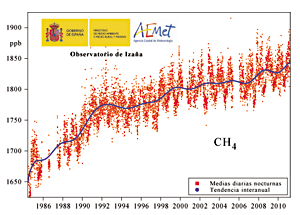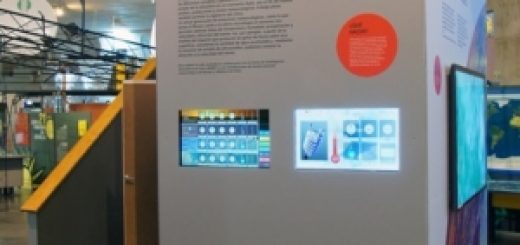Update of the Methane atmospheric series of Izaña (June 1984-March 2011)
The graphic (click it to see the graphic at a larger size) shows the molecular mixing ratios of atmospheric methane (CH4) measured (daily means of the night period) at Izaña Atmospheric Observatory, from 1984 till present. The unit “ppb” indicates number of methane molecules per every billion of dry air molecules. The interannual trend (blue line) has been obtained from the daily mean measurements (red dots) applying a Fourier analysis and keeping only the low frequency harmonics. The interannual methane growth rate decreased from approximately +13 ppb/year between 1985 and 1991 to almost cero (+1.5 ppb/year) between 1999 and 2006, and increased again after 2007. From 2006 to 2008 a net increase of +15 ppb happened, followed by an increase of +3 ppb/year in 2009 and 2010.
Methane is the second most important gas concerning the increased atmospheric greenhouse effect, after carbon dioxide. Methane molecular mixing ratio before the industrial revolution was 715 ppb. The present atmospheric values of CH4 are by far the largest during last 650,000 years (IPCC 2007).
It is believed that methane stability between 1999 and 2006 is due to the approximation to a stable atmospheric mixing ratio resulting from the balance between CH4 sources/sinks constant in time and the destruction of CH4 in the atmosphere, being the posterior increase attributed to an increase in net emissions. Studies based on data from the World Meteorological Organization (WMO) Global Atmosphere Watch (GAW) network pointed out that, probably, the drivers of these increases are as follows: a) greater than average wetland CH4 emissions at high northern latitudes during 2007 owing to exceptionally warm temperatures; and b) tropical emissions during 2007 and 2008 related to greater than normal precipitation in wetland regions during La Niña episode. The reasons for the recent increase in CH4 are not fully understood, and it is uncertain if growth at the same rate will continue.
It has been carried out an exhaustive quality control of continuous Izaña methane measurements comparing them (for the same date and hour) with the weekly NOAA series (1992-2010) obtained from air samples collected in flasks at Izaña. The agreement is good, which confirms, in an independent way, the quality of the continuous CH4 data obtained at Izaña Atmospheric Observatory.








